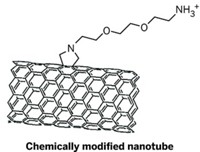Advertisement
Grab your lab coat. Let's get started
Welcome!
Welcome!
Create an account below to get 6 C&EN articles per month, receive newsletters and more - all free.
It seems this is your first time logging in online. Please enter the following information to continue.
As an ACS member you automatically get access to this site. All we need is few more details to create your reading experience.
Not you? Sign in with a different account.
Not you? Sign in with a different account.
ERROR 1
ERROR 1
ERROR 2
ERROR 2
ERROR 2
ERROR 2
ERROR 2
Password and Confirm password must match.
If you have an ACS member number, please enter it here so we can link this account to your membership. (optional)
ERROR 2
ACS values your privacy. By submitting your information, you are gaining access to C&EN and subscribing to our weekly newsletter. We use the information you provide to make your reading experience better, and we will never sell your data to third party members.
Materials
Nanotube Inflammation
Long, thin carbon structures exhibit asbestos-like pathogenicity in mice
by Bethany Halford
May 26, 2008
| A version of this story appeared in
Volume 86, Issue 21

RIGID MULTIWALLED carbon nanotubes (MWNTs) longer than 20 µm elicit the same toxic response in mice that asbestos does, according to two new studies. The results suggest that in humans nanotubes could lead to mesothelioma, the hallmark cancer of asbestos exposure, if sufficient quantities of the material are able to reach the lungs by inhalation.
Occupational exposure to asbestos through mining and industrial operations has led to a pandemic of lung diseases. Workers who inhale asbestos fibers develop inflammation and scarring in the mesothelial lining of the lungs, which can lead to mesothelioma.
Because certain types of carbon nanotubes are structurally similar to asbestos, scientists have speculated that nanotubes might also have asbestos' devastating health effects. "For a fiber to be harmful, it has to be thin, long, and insoluble in the lung," says Ken Donaldson of Scotland's University of Edinburgh Centre for Inflammation Research, who spearheaded one of the studies.
To see whether nanotubes mimic asbestos' toxicological behavior, Donaldson's team injected 50 µg of MWNTs into the abdominal cavity of mice and observed their effect on the mesothelial layer of cells that line the cavity.
They found that when MWNTs were straight and longer than 20 µm, they caused the same type of inflammation and granuloma, or scar formation, as asbestos. The response is predictive of mesothelioma, Donaldson says, although no such cancer was observed in this study. In contrast, shorter MWNTs, tangled nanotube aggregates, and nanoparticulate carbon black didn't cause any inflammation or granuloma formation, further indicating that the toxicity is a function of size and shape, not chemistry (Nat. Nanotechnol., DOI: 10.1038/nnano.2008.111).
A group led by Jun Kanno and Akihiko Hirose of Japan's National Institute of Health Sciences did observe the formation of cancerous lesions consistent with mesothelioma when they injected MWNTs into the abdominal cavity of mice that were genetically predisposed to develop cancer quickly. The Japanese team used a much larger amount of MWNTs than did Donaldson's team—roughly 100 mg of the material—and they observed the animals over a longer period—between 10 days and 25 weeks (J. Toxicol. Sci. 2008, 33, 105).
Kristen M. Kulinowski, executive director for policy at Rice University's Center for Biological & Environmental Nanotechnology, cautions that researchers do not yet know whether carbon nanotubes can be inhaled in sufficient quantities to exhibit the biological response seen in these studies. Even so, she warns that action should be taken to protect workers and consumers.
"As a society, we cannot afford not to exploit this incredible material," says Andrew Maynard, a member of Donaldson's team and chief science adviser of the Project on Emerging Nanotechnologies, "but neither can we afford to get it wrong—as we did with asbestos."
Carbon nanotubes have mechanical, electronic, and other traits that make them attractive for applications ranging from polymer reinforcement to molecular-scale electronic devices.



Join the conversation
Contact the reporter
Submit a Letter to the Editor for publication
Engage with us on Twitter